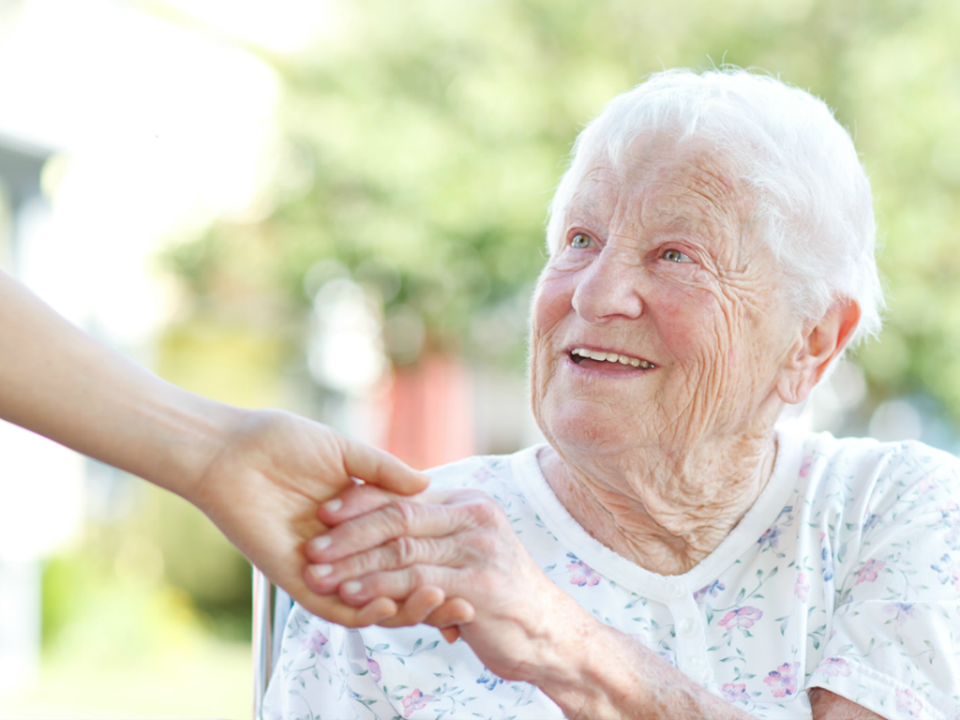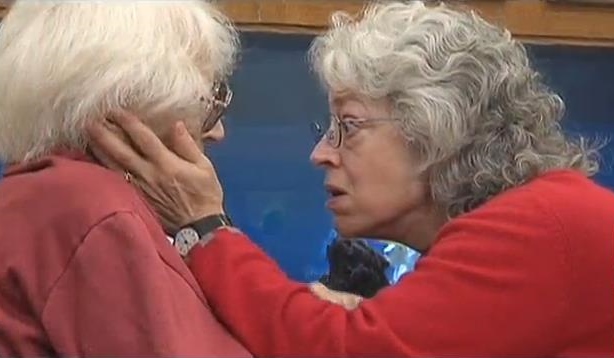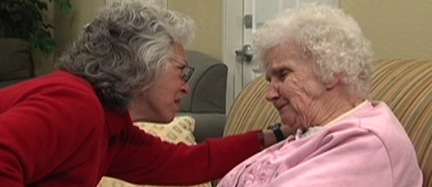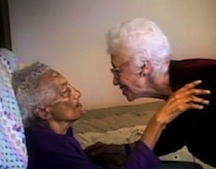by Naomi Feil
Case One
Non-verbal behavior or body language:
Jessie H. sits upright in her wheelchair. Her bright blue eyes piece anyone who goes near. Her facial muscles are tight. Her lips pressed in a straight line. Tiny furrows are etched between her white eyebrows. Her finger points, accusing her caregiver.
Her voice is high-pitched, clear and loud: “You stole my lace underwear!”
Jessie is “Maloriented,” in the first phase of Resolution.
Validation understanding: Her lace underwear is a symbol of her lost youth. Jessie cannot accept the inevitable losses that accompany aging. Her memory is fading. She forgot that she carefully folded her lace underwear, lovingly hiding it in her bottom drawer.
When and where to touch:
 Do not touch Jessie. Very old people, who are “Maloriented” often do not want intimacy. They have always controlled their emotions. Maloriented old people often construe touch as being patronizing. A firm handshake, once you have established a relationship is the touch of choice.
Do not touch Jessie. Very old people, who are “Maloriented” often do not want intimacy. They have always controlled their emotions. Maloriented old people often construe touch as being patronizing. A firm handshake, once you have established a relationship is the touch of choice.
Case Two
Joanne B.’s voice is frantic: “I’m looking for my mother. Have you seen her?
She needs me, right now!” Her voice is shrill, full of fear. Her speech is clear, although sometimes, garbled.
Non-Verbal behavior: Joanne’s movements in space are indirect. She moves here and there, searching. Her facial muscles sag. Her fingers wave in the air. Her mouth is open as she cries.
Joanne is in Phase Two, “Time Confusion.”
Validation understanding: She can no longer tell clock time. Present and past time blend. She can no longer separate seconds, and minutes, days or years. She moves by her lifetime. She uses her mind’s eye (temporal lobe) to see people from the past.
Joanne was on vacation in Florida when her mother died. She returned in time for the funeral. Joanne never told her mother that she loved her. Now, in old age, in Resolution, she struggles to make amends. With her mind’s eye she sees her mother, and needs to talk with her.
When and where to touch:

Once you have established a relationship, gently touch Joanne where her mother touched her in infancy. In Western cultures, a gentle touch, with both hands, using your palm, moving in a circular motion, on the upper cheekbones, is where the mother first touched the child. Each cell remembers the mother’s touch. It is permanently recorded in the body-mind. With this touch, the Validating worker often becomes a mother-substitute. Those in Time Confusion, freely associate, moving back and forth in time.
Joanne can now express her unresolved feelings, and in time, her anxiety is released.
Note: The Validation Worker knows that in Eastern cultures, the touch may be in another area.
Case Three
Body Language: John W. moves his hand in a sawing motion, back and forth. His muscles are relaxed, his lips open and close as he sings with gusto. He moves back and forth in his wheelchair. He does not speak, but repeats, “Bum, bum, deedle bum bum,” over and over. His voice low, melodious, booming. His breathing is labored with effort.
John is in Phase Three, “Repetitive Motion.”
Validation understanding: He has severe cognitive losses. Over a period of seven years, he has lost his speech. He can recall songs from his childhood, and communicates with hand motions and repetitive sounds. John was a lumberjack. He is restoring is identity. With his mind’s eye, he sees the huge oak tree he felled in his youth.
 When and where to touch:
When and where to touch:
Genuinely mirror John’s movements, his facial expression, and voice tone. When you have established some eye contact and a relationship, as he saws, touch him gently on his shoulder using the friend, colleague touch. Maintain that touch with the intention of caring and support. When his sawing motions slow and his breathing slows, you can stop touching. This touch helps John restore his identity. There is joy in making this sort of intimate contact.
Case Four
Body language: Mary lies motionless in bed, sometimes moving her mouth in a sucking motion. She has been bed-ridden for at least 6 months and hasn’t spoken in at least 2 years. She needs assistance with all daily activities.
Validation understanding: Mary is in the final stage, “Vegetation,” and it is often impossible to know what is going on in her mind. From her history we know that she was married, had 4 children and cared for her mother, who lived with them.
When and where to touch:
 Mary will often respond with eye movements and sounds when you use the “Mother Touch.” Approach her gently and slowly, saying hello as you move very close. When you sense that you are close enough so that Mary feels your presence use the ‘Mother Touch’ and perhaps sing a song that her mother might have sung long ago. Combining touch and an appropriate song works beautifully.
Mary will often respond with eye movements and sounds when you use the “Mother Touch.” Approach her gently and slowly, saying hello as you move very close. When you sense that you are close enough so that Mary feels your presence use the ‘Mother Touch’ and perhaps sing a song that her mother might have sung long ago. Combining touch and an appropriate song works beautifully.